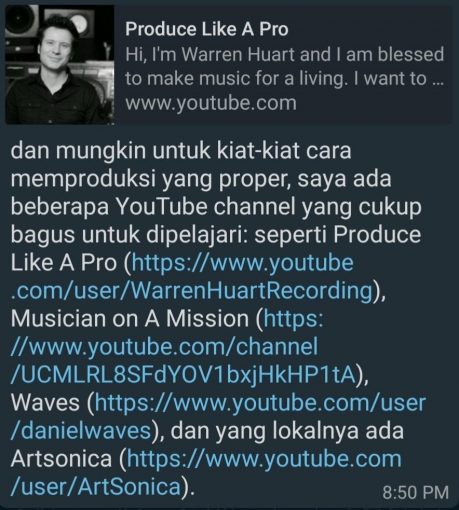
Yogyakarta, July 27th2020—Quarantine that have been going on for a couple of months have made people search for new activities to fill their free time, including learning to make music. To give a picture on how to produce music at home, Fisipol UGM’s Center for Digital Society brought up that topic in its 28thdigital discussion.
In a discussion titled “A Fun Way to Create Music At Home”, CfDS had M. Anada Alifiaarry, a final year Fisipol UGM student who is also a musician and guitarist. Right now, Nanda is a guitarist in the Honest Pineapple band. He is also learning audio production, especially record and music producing, as well as mixing engineer.
After some attendants say that they are interested to create a song cover, Nanda explained that song production, including song covers, can be done at home as long as there is a will. Mastering music instruments and singing techniques are also important aspects if the song that we want to cover a song that is not instrumental.
A basic understanding of audio engineering and music production in general is also an important aspect, especially on how to use devices or software to produce music. Nanda added, other than self skill, another thing that is needed for home music production is devices, such as computer or laptop, microphones, audio interfaces, monitor speaker or headphone, midi controller, XLR cables and digital audio workstation software (DAW).
Actually, in the music production execution, there is no exact theory that needs to be used. “Production results will be easy to listen to depending on the songwriting and the arrangement, not quality and how expensive are devices that we have,” Nanda added to his explanation. For more references, before creating an art can be found anywhere, starting from Youtube, articles from Google, or even experiments and personal experiences.
In the production process, Nanda usually starts the production process by making an early sketch, like making guitar and bass take first before making it into a guideline. After the sketch is finished, Nanda will start to know the song composition he’s going to create. Starting from what instruments he wants to use, the layering, characters, and song reference he refers to. This composition is what helps musicians in delivering the message they want to convey through the song.
Bayu, the moderator of the Digital Discussion, asks Nanda to explain the difficulties he’s been having when making home production music and how he handles it both in the pre-production and production process. One of the pre-production difficulties is creative block. Nanda overcomes this difficulty by listening to songs with the same genre and taking notes on every inspiration that comes in, after that he will move to the production process.
Other than that, obstacles in the production process come more from the terms of supporting production needs, like limitations on instrument resources and on vocal take. Sometimes, obstacles may come from the electric instability at home that can cause noise and hum on audio result. Nanda explained that he usually overcomes this by borrowing instruments from his friends or using other tools that he has at home.
For publication, there are a lot of media that can be used, starting from the free ones to the paid ones. Youtube, Soundcloud, and Bandcamp are free media that can be used to publish music. But if you want to publish it to the digital music platform, the publication procedures are not as easy as Youtube or Soundcloud.
Nanda uses digital music platforms only for promotion, because he doesn’t get a big income from that platform. So the profit that he gets from the publication on the digital platform doesn’t cover the whole production cost. “For me, it is only a medium for musicians and bands to reach their listeners easier” said Nanda.
Nanda then gave some videos about the material that he shared. Nanda also gave some additional references to learn more.
“For me, everybody has their own taste. Every music also has their own market segmentation” Nanda answered the last question from the discussion participant. As he closed the discussion at 9:35 pm, Nanda said that he hopes Indonesia has their own music character, so people from around the world may identify that the song is an Indonesian song even if it’s written in English.
